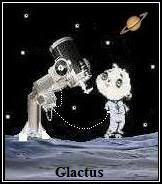Post by glactus on Sept 25, 2011 1:56:19 GMT
Lofar is the world's largest radio telescope, and will map radio signals which have travelled across the universe for billions of years. Scientists expect Lofar to answer questions about the nature of our universe.

Lofar near side
Lofar (Low Frequency Array) is a new kind of radio telescope. It can see radio waves with low frequencies, similar to those that give us FM radio. Rather than collecting signals from individual radio sources, Lofar continuously monitors large swathes of sky. Lofar is more sensitive to the longest observable radio waves than any other telescope. It can see many billions of light years out into space, back to the time before the first stars formed, a few hundred million years after the Big Bang.

Lofar far side
The 192 new radio antennas at Onsala's Lofar station look modest enough. But the radio signals they collect will be linked together with 47 similar stations over the whole of Europe, and sent over Internet to a central supercomputer in the Netherlands. This means huge amount of data traffic: the equivalent of over 7000 DVD films per day just from the Swedish station.

Depp into the void
The telescope creates images of the sky using a unique combination of computer power and innovative software. Together, Lofar's antennas form a single telescope with a diameter of 1300 kilometres.
Scientists expect Lofar to discover hitherto unknown types of astronomical objects. It will also investigate the environments of black holes, find extreme galaxies and pulsars, and search for planets around other stars.
To see stunning video of Lofar just click on the link below. Has sound
www.youtube.com/watch?v=1CqXjTFbaMU

Credits: These are non copywrite images
This is part text only. See full text and all scientists involved at Space Daily.com
www.spacedaily.com/reports/Swedes_makes_world_largest_telescope_bigger_999.html
Video by YouTube

Lofar near side
Lofar (Low Frequency Array) is a new kind of radio telescope. It can see radio waves with low frequencies, similar to those that give us FM radio. Rather than collecting signals from individual radio sources, Lofar continuously monitors large swathes of sky. Lofar is more sensitive to the longest observable radio waves than any other telescope. It can see many billions of light years out into space, back to the time before the first stars formed, a few hundred million years after the Big Bang.

Lofar far side
The 192 new radio antennas at Onsala's Lofar station look modest enough. But the radio signals they collect will be linked together with 47 similar stations over the whole of Europe, and sent over Internet to a central supercomputer in the Netherlands. This means huge amount of data traffic: the equivalent of over 7000 DVD films per day just from the Swedish station.

Depp into the void
The telescope creates images of the sky using a unique combination of computer power and innovative software. Together, Lofar's antennas form a single telescope with a diameter of 1300 kilometres.
Scientists expect Lofar to discover hitherto unknown types of astronomical objects. It will also investigate the environments of black holes, find extreme galaxies and pulsars, and search for planets around other stars.
To see stunning video of Lofar just click on the link below. Has sound
www.youtube.com/watch?v=1CqXjTFbaMU
Credits: These are non copywrite images
This is part text only. See full text and all scientists involved at Space Daily.com
www.spacedaily.com/reports/Swedes_makes_world_largest_telescope_bigger_999.html
Video by YouTube


